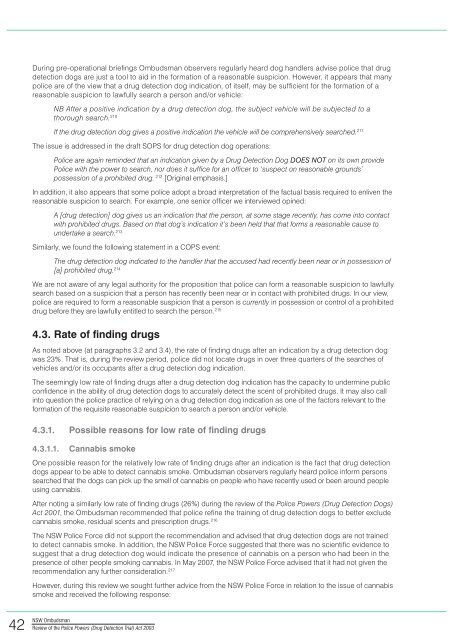Review of the Police Powers (Drug Detection Trial) Act 2003 - NSW ...
Review of the Police Powers (Drug Detection Trial) Act 2003 - NSW ...
Review of the Police Powers (Drug Detection Trial) Act 2003 - NSW ...
You also want an ePaper? Increase the reach of your titles
YUMPU automatically turns print PDFs into web optimized ePapers that Google loves.
During pre-operational briefings Ombudsman observers regularly heard dog handlers advise police that drug<br />
detection dogs are just a tool to aid in <strong>the</strong> formation <strong>of</strong> a reasonable suspicion. However, it appears that many<br />
police are <strong>of</strong> <strong>the</strong> view that a drug detection dog indication, <strong>of</strong> itself, may be sufficient for <strong>the</strong> formation <strong>of</strong> a<br />
reasonable suspicion to lawfully search a person and/or vehicle:<br />
NB After a positive indication by a drug detection dog, <strong>the</strong> subject vehicle will be subjected to a<br />
thorough search. 210<br />
If <strong>the</strong> drug detection dog gives a positive indication <strong>the</strong> vehicle will be comprehensively searched. 211<br />
The issue is addressed in <strong>the</strong> draft SOPS for drug detection dog operations:<br />
<strong>Police</strong> are again reminded that an indication given by a <strong>Drug</strong> <strong>Detection</strong> Dog DOES NOT on its own provide<br />
<strong>Police</strong> with <strong>the</strong> power to search, nor does it suffice for an <strong>of</strong>ficer to ‘suspect on reasonable grounds’<br />
possession <strong>of</strong> a prohibited drug. 212 [Original emphasis.]<br />
In addition, it also appears that some police adopt a broad interpretation <strong>of</strong> <strong>the</strong> factual basis required to enliven <strong>the</strong><br />
reasonable suspicion to search. For example, one senior <strong>of</strong>ficer we interviewed opined:<br />
A [drug detection] dog gives us an indication that <strong>the</strong> person, at some stage recently, has come into contact<br />
with prohibited drugs. Based on that dog’s indication it’s been held that that forms a reasonable cause to<br />
undertake a search. 213<br />
Similarly, we found <strong>the</strong> following statement in a COPS event:<br />
The drug detection dog indicated to <strong>the</strong> handler that <strong>the</strong> accused had recently been near or in possession <strong>of</strong><br />
[a] prohibited drug. 214<br />
We are not aware <strong>of</strong> any legal authority for <strong>the</strong> proposition that police can form a reasonable suspicion to lawfully<br />
search based on a suspicion that a person has recently been near or in contact with prohibited drugs. In our view,<br />
police are required to form a reasonable suspicion that a person is currently in possession or control <strong>of</strong> a prohibited<br />
drug before <strong>the</strong>y are lawfully entitled to search <strong>the</strong> person. 215<br />
4.3. Rate <strong>of</strong> finding drugs<br />
As noted above (at paragraphs 3.2 and 3.4), <strong>the</strong> rate <strong>of</strong> finding drugs after an indication by a drug detection dog<br />
was 23%. That is, during <strong>the</strong> review period, police did not locate drugs in over three quarters <strong>of</strong> <strong>the</strong> searches <strong>of</strong><br />
vehicles and/or its occupants after a drug detection dog indication.<br />
The seemingly low rate <strong>of</strong> finding drugs after a drug detection dog indication has <strong>the</strong> capacity to undermine public<br />
confidence in <strong>the</strong> ability <strong>of</strong> drug detection dogs to accurately detect <strong>the</strong> scent <strong>of</strong> prohibited drugs. It may also call<br />
into question <strong>the</strong> police practice <strong>of</strong> relying on a drug detection dog indication as one <strong>of</strong> <strong>the</strong> factors relevant to <strong>the</strong><br />
formation <strong>of</strong> <strong>the</strong> requisite reasonable suspicion to search a person and/or vehicle.<br />
4.3.1. Possible reasons for low rate <strong>of</strong> finding drugs<br />
4.3.1.1. Cannabis smoke<br />
One possible reason for <strong>the</strong> relatively low rate <strong>of</strong> finding drugs after an indication is <strong>the</strong> fact that drug detection<br />
dogs appear to be able to detect cannabis smoke. Ombudsman observers regularly heard police inform persons<br />
searched that <strong>the</strong> dogs can pick up <strong>the</strong> smell <strong>of</strong> cannabis on people who have recently used or been around people<br />
using cannabis.<br />
After noting a similarly low rate <strong>of</strong> finding drugs (26%) during <strong>the</strong> review <strong>of</strong> <strong>the</strong> <strong>Police</strong> <strong>Powers</strong> (<strong>Drug</strong> <strong>Detection</strong> Dogs)<br />
<strong>Act</strong> 2001, <strong>the</strong> Ombudsman recommended that police refine <strong>the</strong> training <strong>of</strong> drug detection dogs to better exclude<br />
cannabis smoke, residual scents and prescription drugs. 216<br />
The <strong>NSW</strong> <strong>Police</strong> Force did not support <strong>the</strong> recommendation and advised that drug detection dogs are not trained<br />
to detect cannabis smoke. In addition, <strong>the</strong> <strong>NSW</strong> <strong>Police</strong> Force suggested that <strong>the</strong>re was no scientific evidence to<br />
suggest that a drug detection dog would indicate <strong>the</strong> presence <strong>of</strong> cannabis on a person who had been in <strong>the</strong><br />
presence <strong>of</strong> o<strong>the</strong>r people smoking cannabis. In May 2007, <strong>the</strong> <strong>NSW</strong> <strong>Police</strong> Force advised that it had not given <strong>the</strong><br />
recommendation any fur<strong>the</strong>r consideration. 217<br />
However, during this review we sought fur<strong>the</strong>r advice from <strong>the</strong> <strong>NSW</strong> <strong>Police</strong> Force in relation to <strong>the</strong> issue <strong>of</strong> cannabis<br />
smoke and received <strong>the</strong> following response:<br />
42<br />
<strong>NSW</strong> Ombudsman<br />
<strong>Review</strong> <strong>of</strong> <strong>the</strong> <strong>Police</strong> <strong>Powers</strong> (<strong>Drug</strong> <strong>Detection</strong> <strong>Trial</strong>) <strong>Act</strong> <strong>2003</strong>

















